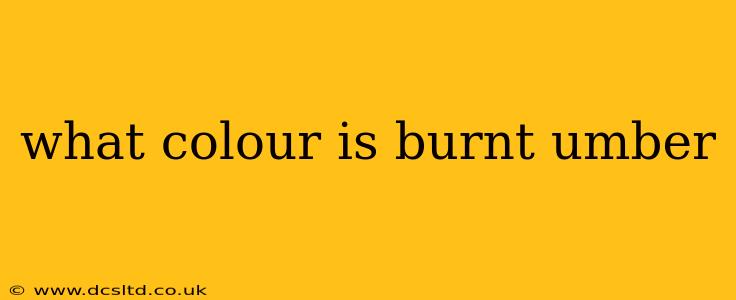Burnt umber is a deeply saturated, warm brown pigment with a complex history and a captivating range of hues. While often described simply as "brown," understanding its nuances helps artists and designers appreciate its versatility and unique character. This article delves into the specifics of burnt umber's color, exploring its variations and applications.
What is Burnt Umber?
Burnt umber is a naturally occurring earth pigment derived from umber, an iron-rich ochre containing manganese oxides. The difference lies in the processing: umber is heated (burnt), which alters its chemical composition, resulting in a darker, richer, and warmer brown. This process changes the color significantly, moving away from the raw umber's more yellowish-brown tones.
So, What Color is Burnt Umber Exactly?
This is where things get interesting. There isn't one definitive answer. The exact shade of burnt umber can vary depending on several factors:
- The source of the umber: Different geographical locations yield umber with varying mineral compositions, leading to variations in the final burnt umber shade.
- The burning process: The intensity and duration of the heating process directly impact the resulting color. A longer or hotter burn will result in a darker, redder brown.
- The manufacturer: Different manufacturers may have slightly different processes or source materials, leading to subtle differences in the final pigment.
- The medium: The color can appear slightly different depending on whether it's used in oils, acrylics, watercolors, or other mediums.
Generally speaking, burnt umber is described as a dark reddish-brown or a deep, warm brown with reddish-brown undertones. Think of the color of rich, dark soil after a rain, or the shade of roasted coffee beans. It often exhibits a slightly translucent quality, allowing underlying colors to subtly show through.
What are the Differences Between Raw Umber and Burnt Umber?
This is a frequently asked question. The key difference lies in the warmth and depth of the color.
- Raw Umber: Typically a yellowish-brown, sometimes with olive or greenish undertones. It's lighter and less intense than burnt umber.
- Burnt Umber: A darker, warmer reddish-brown, possessing greater depth and richness. It's far more intense and opaque than raw umber.
Is Burnt Umber a Reddish Brown or a Brownish Red?
This depends largely on the specific batch and manufacturer. While predominantly brown, the reddish undertones are often prominent enough that "reddish-brown" is a very accurate description. Conversely, in some instances, depending on the lighting and the mixture, the red tones can be slightly more apparent, leaning closer to a "brownish-red" description.
How is Burnt Umber Used?
Burnt umber's versatility makes it a staple in many artists' palettes. It's used for:
- Creating shadows and depth: Its rich tone excels at adding shadows and dimension to paintings.
- Mixing other colors: It acts as an excellent base for mixing other browns, greens, and even deep reds.
- Glazing: Its translucency allows for beautiful glazing effects, adding layers of depth and richness to a painting.
- Underpainting: It serves as a superb underpainting, providing a warm, earthy base for subsequent layers.
In conclusion, burnt umber is not a simple, single shade. Its complex character and rich variations make it a fascinating pigment, appreciated for its depth, warmth, and versatility across various artistic mediums. Understanding these variations helps artists and designers use it more effectively to achieve the desired effects in their work.
